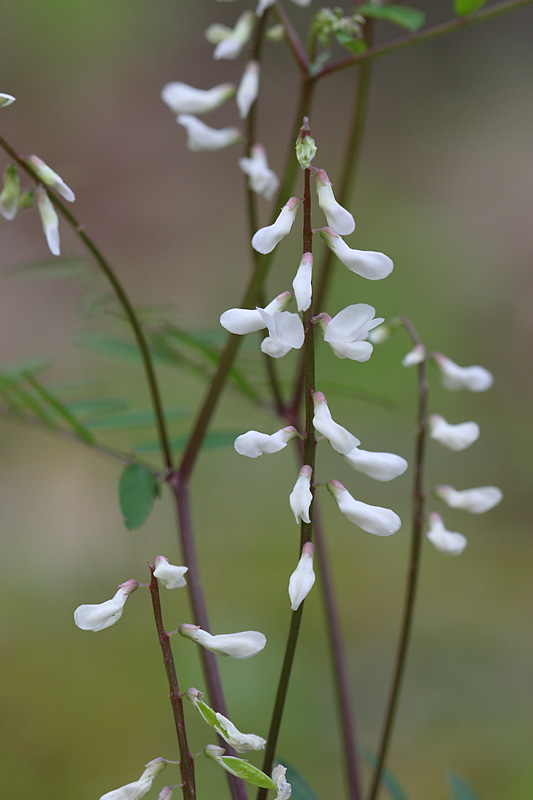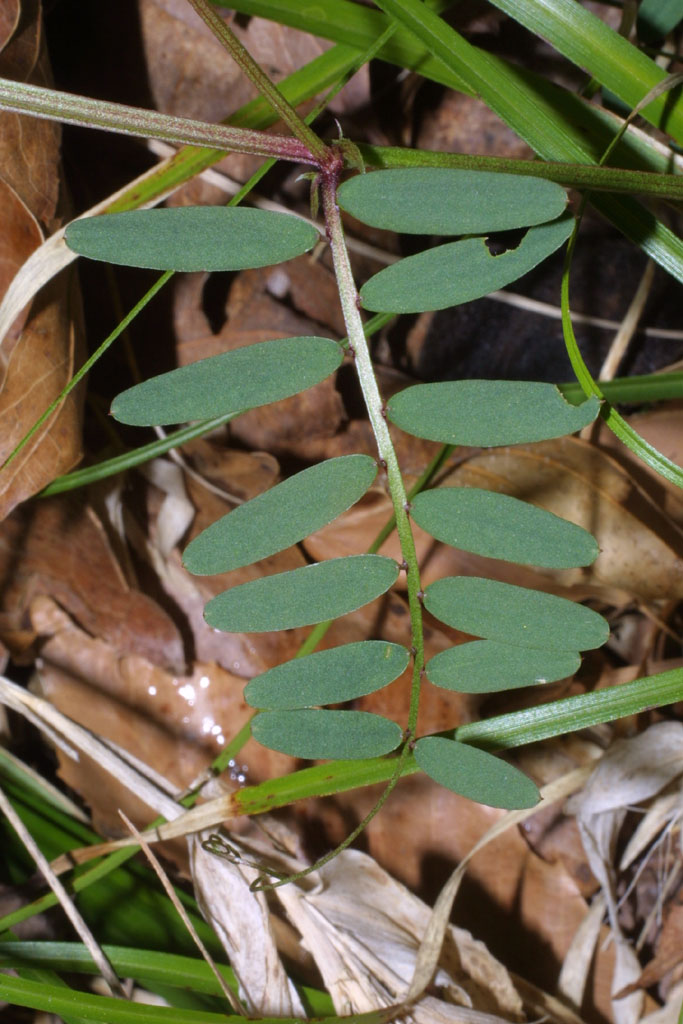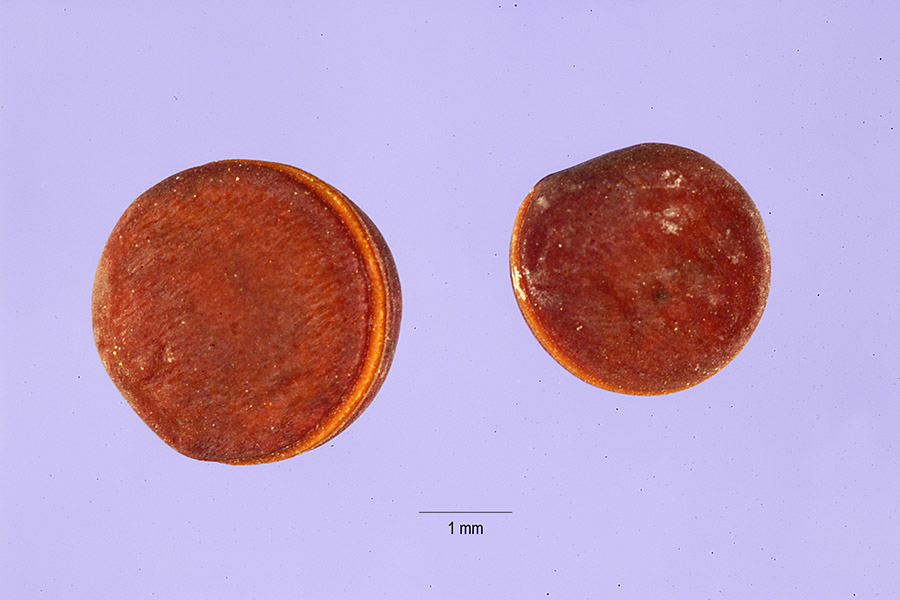 Download PDF
Download PDF
Name: Vicia caroliniana Walter
Family: Fabaceae (the pea or legume family)
 Common Names: Carolina vetch (3), Pale vetch, wood vetch (2)
Common Names: Carolina vetch (3), Pale vetch, wood vetch (2)
Etymology: Vicia is the latin for “Vetch” while “caroliniana” means “from the Carolinas” (5).
Botanical synonyms: Vicia hugeri Small (3); Cracca caroliniana (Walter) Alefeld; Vicia parviflora Michaux (14).
Quick Notable Features:
¬ generally sprawling, occasionally climbing stems with tendrillate leaf tips
¬ pale purple or white corolla with bright yellow or orange anthers
¬ racemes loose with scattered flowers
Plant Height: The stems grow to a length of 1.5m (6). No information was found on how high these stems climb.
Subspecies/varieties recognized: none (3)
 Most Likely Confused with: Other species of Vicia and Lathyrus.
Most Likely Confused with: Other species of Vicia and Lathyrus.
Habitat Preference: Prefers woods and forest edges in the Carolinas (6). Voss (2) notes that it is usually found in dry open ground, often in clearings or at the edges of oak and oak-hickory forests. Hardin (16) reports it as only occurring within the prairie of ecosystems sampled in southern Ohio.
Geographic Distribution in Michigan: V. caroliniana is found in the majority of counties in the southern half of the Lower Peninsula (2).
Known Elevational Distribution: Radford et al. (6) noted that this species is found in South Carolina primarily on mountains and piedmont, but no specific elevation information was recorded.
Complete Geographic Distribution: Native to the United States, V. caroliniana is now found throughout the eastern half of the country, from Texas east to Florida and north to New York and Minnesota. It is also found in Ontario, Canada (1).
 Vegetative Plant Description: A perennial, herbaceous vine. The sparsely pubescent to glabrous stems climb or sprawl to a length of 1.5m. The alternate, finely pubescent compound leaves usually have 5-9 pairs of elliptic-oblong or oblong-lanceolate leaflets per leaf. The leaflets are approximately 0.8-2cm long, rounded and mucronate, with approximately 5-7 lateral veins on each side. The apical-most petiolule is modified at its tip as a simple or branched tendril. Lanceolate or lanceolate-sagittate stipules are present and entire (6,7,9,11). The leaves of Vicia caroliniana are reported to remain green through the winter in central and southern Ohio (17). Vicia caroliniana is a root-nodule forming legume (nitrogen fixing) that is part of a large group of legumes that are capable of cross-inoculating when grown together (15).
Vegetative Plant Description: A perennial, herbaceous vine. The sparsely pubescent to glabrous stems climb or sprawl to a length of 1.5m. The alternate, finely pubescent compound leaves usually have 5-9 pairs of elliptic-oblong or oblong-lanceolate leaflets per leaf. The leaflets are approximately 0.8-2cm long, rounded and mucronate, with approximately 5-7 lateral veins on each side. The apical-most petiolule is modified at its tip as a simple or branched tendril. Lanceolate or lanceolate-sagittate stipules are present and entire (6,7,9,11). The leaves of Vicia caroliniana are reported to remain green through the winter in central and southern Ohio (17). Vicia caroliniana is a root-nodule forming legume (nitrogen fixing) that is part of a large group of legumes that are capable of cross-inoculating when grown together (15).
Climbing Mechanism: Tendrils at the leaf tip (6).
Flower Description: The racemes are axillary, have 7-20 flowers each, and are often shorter than the subtending leaves. The flowers are often borne on one side of the peduncle. The regular or almost regular calyx is villous, with a tube 1.8-2.5mm long and nearly equal triangular calyx lobes 0.5-1mm long. The corolla is pale purple or white, the tip of the keel petal blue, with the banner petal 8-12mm long. The styles are pubescent or villous at the apex, and the 10 stamens are diadelphous (in a group of 9 plus a single 10th stamen) and “terminate obliquely” (7). The anthers are yellow-orange (2,6,7,9,11).
Flowering Time: April – July (6).
Pollinator: Nothing was found about pollination of the species, however the specialized papilionaceous corolla typical of the subfamily suggests insect or specifically bee pollination (13). The Appalachian Grizzled Skipper, an endangered lepidopteran in New Jersey, has been reported to feed on the nectar of V. caroliniana (18).
Fruit Type and Description: A narrow stipitate legume, 1.5-3cm long, with 5-8 seeds/fruit (6).
 Seed Description: The compressed or subglobose seed is 3-4mm in diameter. The attachment scar, found at the margin of the seed, extends “three-fourths around the circumference” (9). Based on descriptions, we believe that the scale bar in the seed image here is in error.
Seed Description: The compressed or subglobose seed is 3-4mm in diameter. The attachment scar, found at the margin of the seed, extends “three-fourths around the circumference” (9). Based on descriptions, we believe that the scale bar in the seed image here is in error.
Dispersal Syndrome: Nothing was found for the species other than a reference to dispersal by animals (19) that we question, given that all other species in the genus are reported to be abiotically dispersed.
Distinguished by: V. caroliniana can be most effectively distinguished from members of the genus Lathyrus by its styles and stamen-tubes. The styles of Vicia are pubescent or villous at the apex; those of Lathyrus are pubescent or villous along the entire upper side of the style. Additionally, the stamen tubes of all Vicia members “terminate obliquely” (7) whereas those of Lathyrus are truncate. A final character that may possibly distinguish Vicia from Lathyrus is the stems – Lathyrus members often have winged stems, unlike V. caroliniana (6,7,9).
V. caroliniana can be distinguished from V. sativa and V. sepium by its peduncle. The latter two have peduncles that are much shorter than the leaves, whereas the peduncle of V. caroliniana is as long as or almost as long as the leaf.
The small legume of V. hirsuta is 6-10mm long and tapers to a beak, unlike the rounded, 1.5-3cm long fruit of V. caroliniana. Additionally, the flowers of V. hirsuta are a third as long as those of V. caroliniana.
V. cracca and V. villosa have dense racemes with overlapping blue or violet flowers, and can be distinguished because V. caroliniana has loose racemes of white or pale purple flowers (6,7,9).
Other members of the family in Michigan: 97 species in 34 genera. Genera Amorpha (2), Amphicarpaea (1), Anthyllis (1), Apios (1), Astragalus (3), Baptisia (3), Caragana (1), Cassia (4), Cercis (1), Coronilla (1), Crotolaria (1), Cytisus (1), Dalea (2), Desmodium (12), Gleditsia (1), Glycine (1), Gymnocladus (1), Hedysarum (1), Lathyrus (10), Lespedeza (8), Lotus (1), Lupinus (3), Medicago (3), Melilotus (3), Pisum (1), Phaseolus (2), Psoralea (1), Robinia (3), Schrankia (1), Storophostyles (1), Tephrosia (1), Trifolium (10), Vicia (9), and Wisteria (2) [1].
Ethnobotanical Uses: V. caroliniana was used by the Cherokee as a treatment to treat aches. Scratches were made on the skin over the location of the aching muscle or joint, and an infusion of the plant was rubbed in. It was also used internally to treat rheumatism, respiration problems, and dyspepsia (4).
 Phylogenetic Information: Within the genus Vicia, V. caroliniana is placed in section Cracca. The genus is a member of the subfamily Faboideae (Papilionoideae) within the family Fabaceae. Fabaceae, along with the Polygalaceae, Quillajaceae, and Surianaceae form the Fabales order. The Fabales, Rosales, Cucurbitales, and Fagales form a monophyletic clade within the Eurosids I within the larger Rosid group of the Eudicot angiosperms (8,10).
Phylogenetic Information: Within the genus Vicia, V. caroliniana is placed in section Cracca. The genus is a member of the subfamily Faboideae (Papilionoideae) within the family Fabaceae. Fabaceae, along with the Polygalaceae, Quillajaceae, and Surianaceae form the Fabales order. The Fabales, Rosales, Cucurbitales, and Fagales form a monophyletic clade within the Eurosids I within the larger Rosid group of the Eudicot angiosperms (8,10).
Interesting Quotation or Other Interesting Factoid not inserted above: Larvae of two subspecies of the silvery blue butterfly Glaucopsyche lygdamus, ssp. Lygdamus and Couperi, have been noted to feed on the closely related, V. sepium. These observations from upstate New York, represent the northern limit for the subspecies Lygdamus (12).
Literature and websites used:
- USDA, NRCS. 2008. The PLANTS Database, Version 3.1, National Plant Data Center, Baton Rouge, LA 70874-4490 USA. http://plants.usda.gov/
- Voss, E. G. 1985. Michigan Flora Part II: Dicots. Ann Arbor, Michigan, USA: Cranbrook Institute of Science.
- ITIS: Integrated Taxonomic Information System http://www.itis.gov/index.html Retrieved October 8, 2009 from the Integrated Taxonomic Information System on-line database.
- Moerman, D. 2006. Native American Ethnobotany. University of Michigan – Dearborn. http://herb.umd.umich.edu/
- Brown, R. W. 1956. Composition of Scientific Words. Washington, D.C., USA: Smithsonian Institution Press.
- Radford, A.E., H.E. Ahles, and C.R. Bell. 1968. Manual of the Vascular Flora of the Carolinas. Chapel Hill, North Carolina, USA: The University of North Carolina Press.
- Gleason, H.A. 1963. The New Britton and Brown Illustrated Flora of the Northeastern United States and Adjacent Canada. New York, New York, USA: Hafner Publishing Co., Inc.
- USDA, ARS, National Genetic Resources Program. Germplasm Resources Information Network – (GRIN) [Online Database]. National Germplasm Resources Laboratory, Beltsville, Maryland. URL: http://www.ars-grin.gov/cgi-bin/npgs/html/paper.pl?language=en&chapter=scient
- Fernald, M. L. 1950. Gray’s Manual of Botany, 8th ed. New York, USA: American Book Company.
- ANGIOSPERM PHYLOGENY GROUP 2003. An update of the Angiosperm Phylogeny Group classification for the orders and families of flowering plants: APG II. Botanical Journal of the Linnean Society 141(4): 399-436.
- Tenaglia, D. 2006. Missouri Plants. http://www.missouriplants.com/Pinkalt/Vicia_caroliniana_page.html
- Dirig, R. and J.F. Cryan. 1991. The Status of Silvery Blue Subspecies (Glaucopsyche lygdamus lygdamus and G. l. couperi: Lycaenidae) in New York. Journal of the Lepidopterists’ Society 45(4): 272-290.
- Zomlefer, W.B. 1994. Guide to Flowering Plant Families. Chapel Hill, North Carolina, USA: The University of North Carolina.
- Wunderlin, R. P., and B. F. Hansen. 2008. Atlas of Florida Vascular Plants (http://www.plantatlas.usf.edu/).Institute for Systematic Botany, University of South Florida, Tampa. Plants http://florida.plantatlas.usf.edu/Plant.aspx?id=3144
- Bushnell, O.A. and W.B. Sarles 1937. Studies on the root-nodule bacteria of wild leguminous plants in Wisconsin. Soil Science 44(6): 409-423.
- Hardin,E.D. Succession in Buffalo Beats prairie and surrounding forest. Bulletin of the Torrey Botanical Club 115(1): 13-24.
- Beatley, J.C. 1956. The winter-green herbaceous flowering plants of Ohio. The Ohio Journal of Science 56(6): 349-377.
- Golden, D.M. 2003. Lepidoptera. In B.E. Beans and L. Niles, eds. Endangered and Threatened Wildlife of New Jersey. New Jersey: Rutgers University Press.
- Chen, J., C.D. Huebner, S.C. Saunders, & B. Song 2002. Plant distribution and diversity across an Ozark landscape. In: Shifley SR, Kabrick JM (eds). 2001 Proceedings of the Second Missouri Ozark Forest Ecosystem Symposium: Post-treatment results of the landscape experiment; St. Louis, MO. Gen. Tech. Rep. St. Paul, MN: U.S. Department of Agriculture.
Image Credits (all used with permission):
1) Image of flowering raceme courtesy and copyright © Daniel W Reed – www.2bnthewild.com
2, 3) Images of leaves and stipules courtesy Steven J. Baskauf, from Bioimages at http://bioimages.vanderbilt.edu/.
4) Image of seeds courtesy Tracey Slotta @ USDA-NRCS PLANTS Database.
5) Species distribution map, derived from the Michigan Flora Online.
Primary Authors: Becca Sonday with editing and additions from John Bradtke and R. J. Burnham
© Robyn J. Burnham, University of Michigan
For additional information on Michigan Plant Diversity web pages please contact Robyn J. Burnham via email: rburnham“at”umich.edu